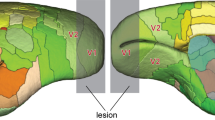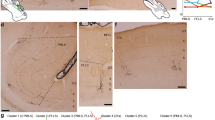Abstract
We examined the distribution of pulvinar afferents to visual area V2 of macaque monkey cerebral cortex in relation to the distribution of the metabolic enzyme cytochrome oxidase (CO). V2 contains three sets of stripelike subregions that are marked by differential staining for CO, and which have different corticocortical connections. The pulvinar provides the major subcortical input to V2, and this input is known to be patchy. We were interested to determine how the pattern of pulvinar afferents relates to the layout of the three stripelike compartments that characterize V2. We made large injections of WGA-HRP into the pulvinar (labelling both the inferior and lateral divisions) and mapped the resulting orthograde terminal and retrograde cell label within V2. We observed pulvinar terminal label mainly in lower layer 3 (at the layer 4 border), with light label in layer 1 as well; terminal label in layers 3–4 was distributed in discrete patches with faint bridges of light label between. Comparison with adjacent sections stained for CO or Cat-301 showed that pulvinar terminal zones aligned precisely with regions of increased CO staining, and targeted both “thick” (Cat-301+) and “thin” CO-rich stripes, avoiding the pale stripes (which aligned with the faint bridges of terminal label). Retrogradely labelled cells were found in layers 5A and 6, but the bulk of the feedback to pulvinar arose from layer 6 rather than layer 5 (unlike V1, where feedback to pulvinar arises primarily from layer 5B). These results show that the increased CO staining in certain subregions of V2 is closely correlated with the presence of thalamic terminals from the pulvinar. Although we cannot rule out the possibility that different sets of pulvinar neurons project to different CO compartments in V2, the presence of a prominent thalamic input shared by the “thick” and “thin” CO stripes (which receive different V1 afferents and make different feedforward projections to other visual cortical areas) could underlie the preferential intrinsic interconnections shown to exist between these V2 subregions and suggests another potential source of integration between the two cortical visual streams.
Similar content being viewed by others
References
Baizer JS, Ungerleider LG, Desimone R (1991) Organization of visual inputs to the inferior temporal and posterior parietal cortex in macaques. J Neurosci 11:168–190
Baleydier C, Morel A (1992) Segregated thalamocortical pathways to inferior parietal and inferotemporal cortex in macaque monkey. Vis Neurosci 8:391–405
Bender DB (1982) Receptive field properties of neurons in the macaque inferior pulvinar. J Neurophysiol 48:1–17
Benevento LA, Rezak M (1976) The cortical projections of the inferior pulvinar and adjacent lateral pulvinar in the rhesus monkey (Macaca mulatta): an autoradiographic study. Brain Res 108:1–24
Bullier J, Kennedy H (1983) Projection of the lateral geniculate nucleus onto cortical area V2 in the macaque monkey. Exp Brain Res 53:168–172
Curcio CA, Harting JK (1978) Organization of pulvinar afferents to area 18 in the squirrel monkey: evidence for stripes. Brain Res 143:155–161
Cusick CG, Scripter JL, Darensbourg JG, Weber JT (1993) Chemoarchitectonic subdivisions of the visual pulvinar in monkeys and their connectional relations with the middle temporal and rostral dorsolateral visual areas, MT and DLr. J Comp Neurol 336:1–30
Desimone R, Wessinger M, Thomas L, Schneider W (1990) Attentional control of visual perception: cortical and subcortical mechanisms. Cold Spring Harb Symp Quant Biol 55:963–971
DeYoe EA, Van Essen DC (1985) Segregation of efferent connections and receptive field properties in visual area V2 of the macaque. Nature 317:58–61
Felleman DJ, Van Essen DC (1991) Distributed hierarchical processing in primate cerebral cortex. Cereb Cortex 1:1–47
Fitzpatrick D, Itoh K, Diamond IT (1983) The laminar organization of the lateral geniculate body and the striate cortex in the squirrel monkey (Saimiri sciureus). J Neurosci 3:673–702
Gibson AR, Hansma DI, Houk JC, Robinson FR (1984) A sensitive low artifact TMB procedure for the demonstration of WGA-HRP in the CNS. Brain Res 298:235–241
Hardy SGP, Lynch JC (1992) The spatial distribution of pulvinar neurons that project to two subregions of the inferior parietal lobule in the macaque. Cereb Cortex 2:217–230
Hendrickson AE, Wilson JR, Ogren MP (1978) The neuroanatomical organization of pathways between the dorsal lateral geniculate nucleus and visual cortex in Old World and New World primates. J Comp Neurol 182:123–136
Hendry SHC, Yoshioka T (1994) A neurochemically distinct third channel in the macaque dorsal lateral geniculate nucleus. Science 264:575–577
Hendry SHC, Jones EG, Hockfield S, Mackay RDG (1988) Neuronal populations stained with the monoclonal antibody Cat-301 in the mammalian cerebral cortex and thalamus. J Neurosci 8:518–542
Hockfield S, Mackay RDG, Hendry SHC, Jones EG (1983) A surface antigen that identifies ocular dominance columns in the visual cortex and laminar features of the lateral geniculate nucleus. Cold Spring Harb Symp Quant Biol 48:877–889
Hubel DH, Livingstone MS (1987) Segregation of form, color, and stereopsis in primate area 18. J Neurosci 7:3378–3415
Jones EG (1984) Laminar distribution of cortical efferent cells. In: Peters A, Jones EG (eds) Cerebral cortex, vol 1. Plenum Press, New York, pp 521–553
Kennedy H, Bullier J (1985) A double-labelling investigation of the afferent connectivity to cortical areas V1 and V2 of the macaque monkey. J Neurosci 5:2815–2830
Kennedy H, Dehay C, Bullier J (1986) Organization of the callosal connections of visual areas V1 and V2 in the macaque monkey. J Comp Neurol 247:398–415
Levitt JB, Yoshioka T, Lund JS (1992) Intrinsic connectivity in macaque V2: evidence for interaction between functional streams. Soc Neurosci Abstr 18:294
Levitt JB, Yoshioka T, Lund JS (1994a) Intrinsic cortical connections in macaque visual area V2: evidence for interaction between different functional streams. J Comp Neurol 342:551–570
Levitt JB, Kiper DC, Movshon JA (1994b) Receptive fields and functional architecture of macaque V2. J Neurophysiol 71:2517–2542
Livingstone MS, Hubel DH (1982) Thalamic inputs to cytochrome oxidase-rich regions in monkey visual cortex. Proc Natl Acad Sci USA 79:6098–6101
Livingstone MS, Hubel DH (1984) Anatomy and physiology of a color system in the primate visual cortex. J Neurosci 4:309–356
Livingstone MS, Hubel DH (1987) Connections between layer 4B of area 17 and the thick cytochrome oxidase stripes of area 18 in the squirrel monkey. J Neurosci 7:3371–3377
Lund JS, Lund RD, Hendrickson AE, Bunt AH, Fuchs AF (1975) The origin of efferent pathways from the primary visual cortex, area 17, of the macaque monkey as shown by retrograde transport of horseradish peroxidase. J Comp Neurol 164:287–304
Lund JS, Hendrickson AE, Ogren MP, Tobin EA (1981) Anatomical organization of primate visual cortex area VII. J Comp Neurol 202:19–45
Mishkin M, Ungerleider LG, Macko KA (1983) Object vision and spatial vision: two cortical pathways. Trends Neurosci 6:414–417
Morel A, Bullier J (1990) Anatomical segregation of two cortical visual pathways in the macaque monkey. Vis Neurosci 4:555–578
Ogren MP, Hendrickson AE (1977) The distribution of pulvinar terminals in visual areas 17 and 18 of the monkey. Brain Res 137:343–350
Olavarria JF, Lewis JW (1992) The distribution of callosal cells orrelates with dense cytochrome oxidase stripes in V2 of the macaque monkey. Soc Neurosci Abstr 18:293
Olszewski J (1952) The thalamus of the Macaca mulatta. Karger, Basel
Peterhans E, Heydt R von der (1993) Functional organization of area V2 in the alert macaque. Eur J Neurosci 5:509–524
Robinson DL, Petersen SE (1992) The pulvinar and visual salience. Trends Neurosci 15:127–132
Shipp S, Zeki S (1985) Segregation of pathways leading from area V2 to areas V4 and V5 of macaque monkey visual cortex. Nature 315:322–325
Trojanowski JQ, Jacobson S (1976) Areal and laminar distribution of some pulvinar cortical efferents in rhesus monkey. J Comp Neurol 169:371–392
Trojanowski JQ, Jacobson S (1977) The morphology and laminar distribution of cortico-pulvinar neurons in the rhesus monkey. Exp Brain Res 28:51–62
Ungerleider LG, Mishkin M (1982) Two cortical visual systems. In: Ingle DJ, Goodale MA, Mansfield RJW (eds) Analysis of visual behavior. MIT Press, Cambridge Mass, pp 549–586
Wong-Riley MTT (1976) Projections from the dorsal lateral geniculate nucleus to prestriate cortex in the squirrel monkey as demonstrated by retrograde transport of horseradish peroxidase. Brain Res 109:595–600
Wong-Riley M, Carroll EW (1984) Quantitative light and electron microscopic analysis of cytochrome oxidase-rich zones in V-II prestriate cortex of the squirrel monkey. J Comp Neurol 222:18–37
Yoshioka T, Blasdel GG, Levitt JB, Lund JS (1994) Relation between patterns of intrinsic lateral connectivity, ocular dominance, and cytochrome oxidase-reactive regions in macaque monkey striate cortex. Cereb Cortex (in press)
Author information
Authors and Affiliations
Rights and permissions
About this article
Cite this article
Levitt, J.B., Yoshioka, T. & Lund, J.S. Connections between the pulvinar complex and cytochrome oxidase-defined compartments in visual area V2 of macaque monkey. Exp Brain Res 104, 419–430 (1995). https://doi.org/10.1007/BF00231977
Received:
Accepted:
Issue Date:
DOI: https://doi.org/10.1007/BF00231977




